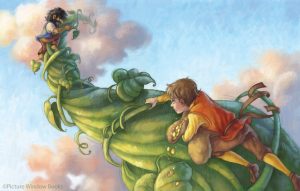Jack the Trickster

Jack and the Beanstalk, a popular English fairy tale, originated in 1734 as “The Story of Jack Spriggins and the Enchanted Bean,” according to Fairy Tale Central. In reality, Jack is a symbolic persona, making appearances in other Jack tales, including “Jack the Giant Killer,” “Little Jack Horner,” and even “Jack Frost.” What all of these characters have in common is the Trickster achetype.
The Trickster archetype embodies unbridled, youthful energy marked by cunning, mischievousness and, if pushed to extremes by circumstance, maliciousness. Carl Jung, the Swiss psychiatrist and psychoanalyst who founded analytical psychology and conceived of the concept of archetypes as part of the universally shared fabric of the collective unconsciousness, had a dark version of the Trickster.
Roots of the Trickster
Jung wrote, “In his clearest manifestations, he is a faithful reflection of an absolutely undifferentiated human consciousness, corresponding to a psyche that has hardly left the animal level.” To borrow a term from Jung’s estranged mentor, Sigmund Freud, the Trickster is undiluted Id. In their book American Indian Myths and Legends, the authors Richard Erdoes and Alfonso Ortiz characterize the Trickster as “. . . always hungry for another meal swiped from someone else’s kitchen, always ready to lure someone else’s wife to bed, always trying to get something for nothing, shifting shapes (and even sex), getting caught in the act, ever scheming, never remorseful” (p. xiii).
However, because the Trickster, in the words of Jung, is “an archetypal psychic structure of extreme antiquity,” he evolved over millennia as the tributaries of multiple cultures, formed rivers of thought that flow through modern literature, art, and cinema. From the zany pranks of Bugs Bunny, to the crafty, nearly quasi-bipolar antics of Willy Wonka, to the havoc-wreaking twins Fred and George Weasley of the Harry Potter movies, the Trickster is imbued in our consciousness in an almost heroic fashion.

Source:https://www.weasyl.com/~dodgyrommer/submissions/635542/brer-rabbit-and-brer-fox
Trudier Harris, J. Carlyle Sitterson Professor of English, Emerita at the University of North Carolina, reframes the Trickster this way: “By definition, tricksters are animals or characters who, while ostensibly disadvantaged and weak in a contest of wills, power, and/or resources, succeed in getting the best of their larger, more powerful adversaries.” Harris traces the American Trickster back to African American folktales, with Br’er Rabbit as “the quintessential trickster figure in African American folklore,” who uses his savvy and strategic intelligence to overcome difficult situations.
This is the modern version of the Trickster with which most of us are familiar: the sly, intelligent, perceptive underdog who undertakes risks to improve his, and by extension, others’ lots in life. Such is the case with Jack, as he uses his shrewdness to conquer the giant, thereby rescuing he and his mother from the clutches of devastating poverty. For Jack, it was a form of creative destruction, a life-affirming, act of material and spiritual innovation.
Implications of the Trickster
There are some obvious morals to glean from Jack and the Beanstalk: taking risks pays off, fortune favors the bold, seize the moment, always have an ax at the ready. (Okay, that’s not one, but it surely helped Jack!)
But if you peel back the layers while holding true to the Trickster archetype, another theme emerges. At some point in your life, you may have to destroy something important, if not seemingly precious, to grow and move on with your life. For Jack, he had to destroy the heaven-reaching beanstalk as a means to ensure he and his mother prospered. In a similar fashion, Luke Skywalker Force projects himself to take on Kylo Ren on Crait, an action that leads to his death, elevating the Trickster to hero status.
Reflecting upon my own life yields as similar theme. My wife and I quit our long-tenured jobs and move nearly 700 miles to another state to start new careers, and more importantly, a new life. In the process, we sold our house of nearly 17 years. In that time span, our house became a home in the truest sense.
My wife and I watched our son grow from a quirky toddler, to an awkward adolescent, to an intelligent, sensitive young man. Like most families, we ate our meals there, watched television together, said good morning and goodnight to each other. As husband and wife, we fought in that house, made love in that house, and threw outrageous parties (and paid heavenly bills.) The better part of our married lives, essential components of our shared identity, were created in that house.
Yet, it was time to let it all go and build something new. And we have no regrets, because out of the creative destruction comes growth, a new beanstalk that promises new adventures and treasures. So, if you feel stuck in life, grab your metaphorical ax, and get busy. Just don’t steal it from someone else, ‘cause that ain’t cool. (Also, grinding bones to make bread is strictly prohibited.)



